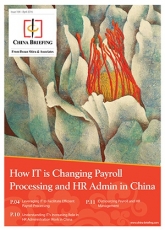Converting from an RO to a WFOE: Considerations Prior to the Official Announcement to Employees
 By Maria Kotova and Allan Xu, Dezan Shira & Associates
By Maria Kotova and Allan Xu, Dezan Shira & Associates
Editor: Jake Liddle
When an entity starts to expand and it is no longer advantageous to operate a Representative Office (RO), a company may look to establish a Wholly Foreign-Owned Enterprise (WFOE) in China. Timing is key to a smooth employee transfer from an RO to a WFOE (target company), as explored here. However, equally important are the provisions and considerations an entity must take before making an official announcement to employees in order to avoid unnecessary legal disputes with current employees during the process. Here, we provide suggestions and tips for handling employee transfer during the RO-WFOE conversion, and guide the investors through the preparation steps prior to terminating the employees.
Precautionary Steps
An RO is not an independent legal entity, and therefore cannot directly employ staff. ROs may hire employees via HR agents such as a Foreign Enterprise Human Resources Service Company (FESCO), which largely complicates the hiring procedure. Furthermore, employees are likely to be reluctant to sign termination agreements unless immediate work is arranged. As such, to best maintain a smooth handover, the RO must transfer employees to the target WFOE without a gap in employment contract. Outlined below are some steps for preparation prior to the entity’s official announcement. These precautionary measures should be taken in order to mitigate potential risks and to provide a framework for employees to transfer to the target WFOE:
- Obtain business license and official seal of the WFOE.
Essentially, these are the necessary materials obtained to fully establish a WFOE. Once a business license is obtained, a WFOE legally exists and can enter into labor relations when the official seals are carved.
- Prepare a bank account and inject registered capital into it. Open a social insurance account and housing fund account.
Generally, a WFOE can legally hire employees once the business license obtained, but the labor relationships with the employees will only be recognized once a bank account is opened and capital is injected. This is critical for timely payment of both salary and social security contributions since such procedures may, in some cases, be delayed for more than a month for various reasons. However, salary and social contributions should be paid within the first month after transition.
- Collect information of employees, including average monthly salary, term of employment, date of employment, position, work hours, annual leave balance and other information that may differ from that on a contract.
Collection of this information is vital in order to understand liabilities of the employer, to decide who will be transferred and to correctly calculate severance pay in case of termination of contract or contract negotiation. This will ensure that all procedures in connection with the labor transfer are executed in a legal and proper way. Moreover, it is also essential to keep the same benefits previously provided under current packages in the process of drafting a new labor contract to be offered under WFOE employment.
- Senior staff should hold a meeting with all the employees present to announce the decision of transition and transferal plans, outlining the reasons for why staff transfer is necessary, i.e. adjustments to business strategy and structure. They must also be informed that the RO is to be deregistered. It is important that each employee signs an acknowledgement of the announcement.
This is to ensure that each employee is clearly informed of the situation and the company’s decision. Without evidence of acknowledgement, if the employer and employee do not reach an agreement, the employee can potentially deny being aware of the announcement, and claim it as illegal termination. The RO, along with FESCO, may be obliged to pay higher severance pay as a compensation.
- A clear timeline, including the date of announcement issuance, time period for employees to make a decision (such as one week), a deadline for signing a termination agreement with FESCO and signing of a new employment contract with new WFOE should be provided.
This provides employees with a clear schedule and time frame in which to perform the transfer preparations.
![]() RELATED: Payroll and Human Resource Services
RELATED: Payroll and Human Resource Services
In Case of Contract Termination or Negotiation
Any sort of disruption such as arbitration or legal action will drastically impact the transition process as it can incur ongoing expenses. Therefore, it is in a company’s utmost interest to avoid any problems, and to come to cordial agreements with employees who object to being transferred or wish to negotiate contracts or severance payment. Further steps must be taken to reach such agreement, including negotiation of the termination clause, termination agreement conclusion and severance payment. An employer can check the remaining period of an employee’s contract and if the period is as short as one or two weeks, the employer can wait until the contract expires in order to avoid labor disputes. If the remaining period is too long, an employer may come to an amicable termination with the employee.
Term of service can be a transferal concern for an employee, especially in terms of severance pay. For example, if an employee had worked at an RO for a total of five years and are subsequently transferred to a WFOE, they may be concerned whether or not the previous five years of service are carried over when they sign a labor contract with the new WFOE or if future severance pay is calculated from zero at the beginning of the new contract. Therefore, an employer would generally reassure the employees that their employment period would continue to accumulate under the new entity. Nonetheless, an employer must be aware of two severance options in case of legal action on behalf of an employee:
- Pay accumulative severance based on previous service years; or
- Continue cumulatively calculating the length of service under the new contract (this option avoids paying up front).
If it comes to the negotiation stage, it is essential that any negotiation is recorded and signed for as means of protection and evidence in case of further dispute. Again, if the company is found to have illegally terminated the employment contract, they may be obliged to pay higher severance pay. Negotiation, of course, should be treated on a case by case basis and by each employee’s contract review, as considerations such as pregnancy or maternity leave and work injuries or medical treatment will impact a decision.
Additionally, there is also potential risk that the amount of social welfare contributions made by the employee may be higher for some employees compared to current contributions. Therefore, the employer may choose one of the options available to negotiate with employees.
|
Asia Briefing Ltd. is a subsidiary of Dezan Shira & Associates. Dezan Shira is a specialist foreign direct investment practice, providing corporate establishment, business advisory, tax advisory and compliance, accounting, payroll, due diligence and financial review services to multinationals investing in China, Hong Kong, India, Vietnam, Singapore and the rest of ASEAN. For further information, please email china@dezshira.com or visit www.dezshira.com. Stay up to date with the latest business and investment trends in Asia by subscribing to our complimentary update service featuring news, commentary and regulatory insight. |

 Human Resources and Payroll in China 2015
Human Resources and Payroll in China 2015
This edition of Human Resources and Payroll in China, updated for 2015, provides a firm understanding of China’s laws and regulations related to human resources and payroll management – essential information for foreign investors looking to establish or already running a foreign-invested entity in China, local managers, and HR professionals needing to explain complex points of China’s labor policies.
 How IT is Changing Payroll Processing and HR Admin in China
How IT is Changing Payroll Processing and HR Admin in China
In this edition of China Briefing magazine, we examine how foreign multinationals can take better advantage of IT in the gathering, storing, and analyzing of HR information in China. We look at how IT can help foreign companies navigate China’s nuanced payroll processing regulations, explain how software platforms are becoming essential for HR, and finally answer questions on the efficacy of outsourcing payroll and HR in China.
 Labor Dispute Management in China
Labor Dispute Management in China
In this issue of China Briefing, we discuss how best to manage HR disputes in China. We begin by highlighting how China’s labor arbitration process – and its legal system in general – widely differs from the West, and then detail the labor disputes that foreign entities are likely to encounter when restructuring their China business. We conclude with a special feature from Business Advisory Manager Allan Xu, who explains the risks and procedures for terminating senior management in China.
- Previous Article 2016 Best China Law & Business Blogs
- Next Article Machen Sie sich in China strafbar, wenn Sie Löhne nicht auszahlen?









